This post contains affiliate links. If you click on a link and make a purchase I earn a small commission at no extra cost for you.
These small compact 10×25 or 12×25 binoculars with Porro prisms design have become real bestsellers in the last few months. For most non-professional binocular users, it seems that a low price and a high magnification are all that matters. But that might be well justified, if you only occasionally use binoculars to look at some far away stuff, you don’t need high-performance binoculars that cost $ 500 or more.
12×25 Compact Binoculars
There are quite a few of the 12×25 compact roof prism binoculars mentioned, all of which look pretty much the same and also have pretty similar specifications. When you read the product description, they advertise and promise a lot for very little money. Most of them brag with professional, high performance, FMC, low light, night vision, and so on.
You will find quite a lot of quite similar models if you google for “12×25 compact binoculars” or search them on amazon.
Mksutary Binoculars 12×25
 So I just picked the Mksutary 12×25 Binoculars, I thought that’s as good as any other, in any case, it was unbeatable cheap.
So I just picked the Mksutary 12×25 Binoculars, I thought that’s as good as any other, in any case, it was unbeatable cheap.
I’ve never heard of the Mksutary brand before, but yes, the budget binocular market is teeming with weird new brands that nobody has ever heard of.
When you google who the manufacturers are, you often come across large companies that manufacture electronic components and all sorts of other gadgets.
But they all have one thing in common, they bring products on the market that are really unbeatable cheap, and often there are even tons of accessories included. Now let’s see if that’s any good.
Mksutary 12×25 Poro Prism Binoculars
The Mksutary 12×25 binoculars were really really cheap, the whole package including the shipping was about 20 $. You really have to wonder where they are making a profit. The package includes a small carry case, a strap, and a microfiber cloth.
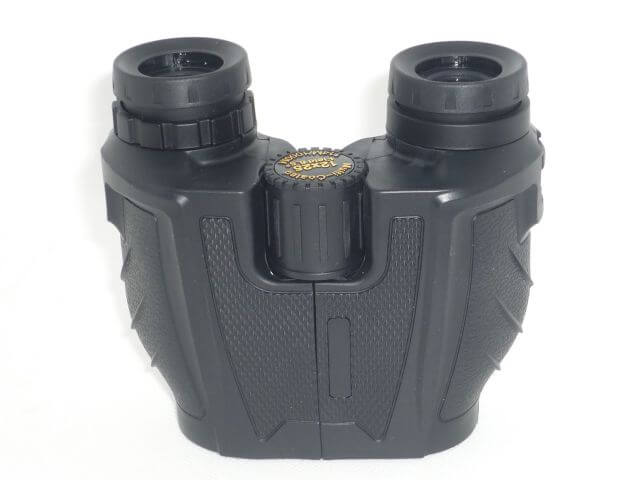
Specifications
| Optical Glass | Standart Crown |
| Lens Coating | Fully Multi-coated |
| Prism systems | said BAK4 in the specs but seems more like BK7 |
| Magnification | 12 |
| Objective diameter | 25 mm |
| Exit pupil | 2 mm |
| Eye relief | 10 mm est. |
| Field of view | 114m/1000m 341ft/1000yrd 6.5° |
| Close focus | 12 feet 4 meter |
| Twilight factor | 17.3 |
| Water resistance | Water-resistant? |
| Weight | 9.8 oz/ 278 gr |
Compact Binoculars so cheap? Is that any good?
When you hold the binoculars in your hand for the first time, the thing is more compact than expected. Well, it’s 12×25. It’s very light, just under 10 ounces, and has grippy rubber armor on what appears to be a polycarbonate chassis.
Mechanics
The hinge of the middle bridge moves smoothly and evenly, by about 35 degrees. This sets the interpupillary distance from 2.36 inches (6 cm) to a maximum of 2.95 inches (7.5 cm), which fits most people.
The right eyepiece has a diopter compensation, it only says +/- on a small scale. The rubber eyecups pop out with a twist by about 1/20 of an inch (6 mm), which is sufficient given the short eye relief.
The center focus wheel is large, and easy to reach with the index finger, but it is still a bit unusual. While most binoculars require one and a half to 2 revolutions from very close to very far, you can count as many as 8 revolutions with this device. Mh, that’s a bit much. It takes what feels like an eternity to focus from near to far. This may allow extremely precise fine focusing, but you want to focus quickly on binoculars. Such a fine thread is expected from a microscope

Optical Performance
12x magnification is quite a lot for small compact binoculars and might bring stability issues. It could be difficult to hold the thing still so that the images don’t blur, which is difficult because of the low weight.
A 25mm lens is quite small, but sufficient for daytime observation when there is enough light. Less so when the light is rather weak when it is cloudy or you are out in the shady forest. After all, in a 12 x 25 instrument, the exit pupil is also quite small with just over 2 mm, not very suitable for twilight or at night with only little residual light. The so-often advertised “night vision” does not exist with such compact glasses.
However, the optical performance of binoculars depends not only on the magnification and the lens diameter but also to a much greater extent on the quality and processing of the optical glass.
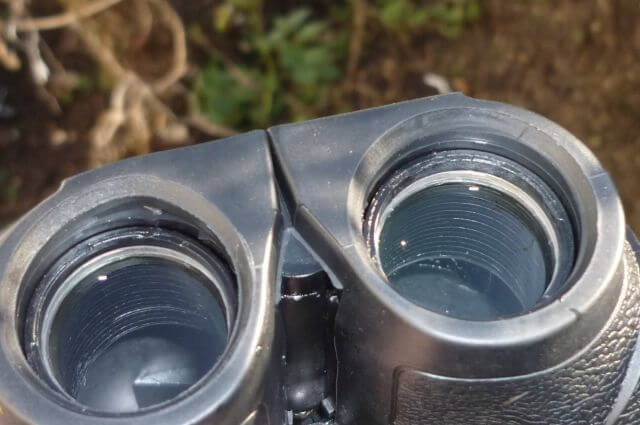
Lens Coating
The lenses are fully multi-coated. This reduces the reflection and ensures brighter images. Anti-reflective lens coatings are essential, otherwise, modern binoculars with their many lenses would lose too much light so that everything would look quite dark through it.
When looking into the front lens, you can actually see through quite well, the glasses are clear, and the inner walls are black. If you hold it at an angle into the light, you can see a greenish coating, and the surroundings are clearly reflected in the lens. Avoid the models with ruby red coatings.
Porro Prisms
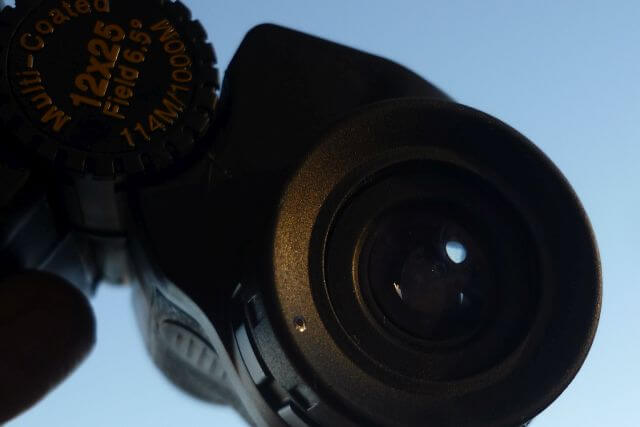
Prisms are essential in binoculars to see an upright normal image. Frequently used types of glass for prisms are the crown glasses BK7 and BaK4, the latter being more expensive but giving the Bino better optical performance in terms of resolution and a bright, color-true image.
To tell the difference hold the binoculars into the light and look at the exit pupil. If it’s a BaK4 glass you can see a beautiful round exit pupil, it is a BK7 prism angular shadowing appear.
BaK4 was specified in the Mksutary specs, but if you carry out the test just recommended, it seems more like BK7 prisms.
Well, that’s funny, so the specifications don’t always seem too correct.
Eye Relief
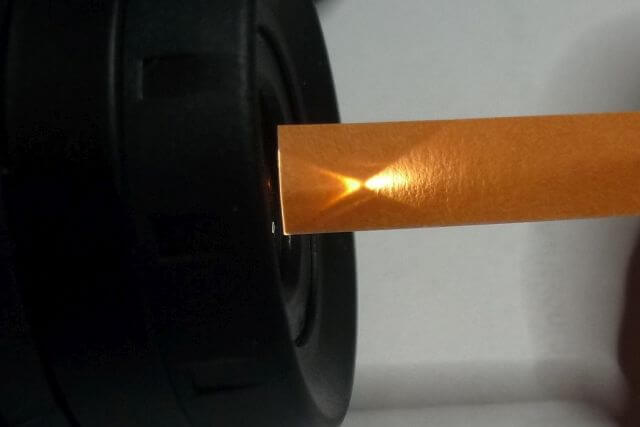 An exact specification regarding the eye relief was not given in the product description either. I then just allowed myself an approximate estimate. With the help of a strip of paper and a light source, I get about 10 to 12 mm.
An exact specification regarding the eye relief was not given in the product description either. I then just allowed myself an approximate estimate. With the help of a strip of paper and a light source, I get about 10 to 12 mm.
When the eyecups are folded in (about 3mm from the lens to the eyecup edge) my eyes are too close and I have shadows on the side field of view, when the eyecups are unfolded, the field of view is fully there.
So for me as a non-wearer of glasses (only for reading) viewing with the Mksutary is problem-free and surprisingly comfortable. I’ll have to ask someone who wears glasses how he copes with it.
Close Focus
In the close range, I was able to bring it into focus at objects that are about 12 feet away, after seemingly endless turning of the focus wheel.
Collimation
The collimation of the two optical axes of the binocular tubes to avoid double images and thus for fatigue-free, relaxed observation is a prerequisite. In budget binoculars, not every instrument is quality controlled before it lands on the shelf. So if the images don’t overlap or jump when you alternately blink your eyes, then something is wrong.
The model I have purchased and which I am trying out here extensively has an almost perfectly aligned optical axis.
Edge sharpness and Edge Blurring


When looking at objects at different distances, it takes a long to focus on the object. As already mentioned above, this is due to the focus wheel that requires so much turning to focus from near to far. But once you have it in focus, the images in the inner 30 -40% of the field of view are satisfactorily sharp. Blurring increases towards the edge. But what’s there to complain, at that price.
Distortion
Distortion towards the edge of the image is also to be expected considering the low purchase price of the optics. As I just said, for the low price one shouldn’t complain.
Color fidelity
The same applies to the color fidelity of the image. With everyday observations, the colors appear a little colder through the binoculars than in reality. But in no way disturbing.

Pros
- Small and compact, ideal as backup binoculars that you can carry in your pocket or in the glove compartment just in case.
- Practical, you can have them handy when you need them, e.g. on the hunt when things have to move quickly, or
- When hiking, wear them around your neck and always have them to hand.
- Very cheap to buy.
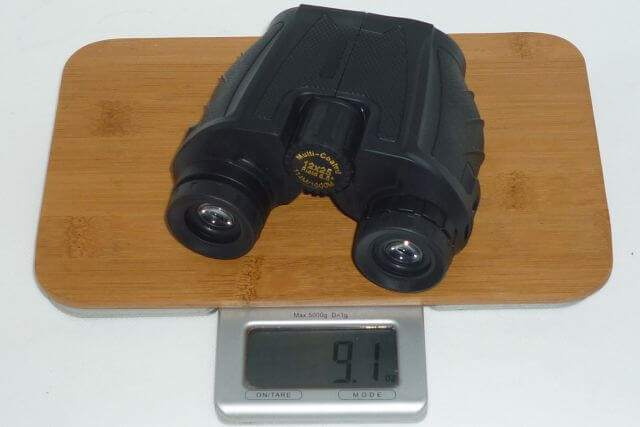
Cons
- The specifications listed don’t always match the product
- The smaller lens diameter means that less light is collected. This is not a problem in daylight, but you cannot use them at dusk or at night. 12×25 produces an exit pupil only 2 mm in size and only little light enters the eye. In low light or at night when the pupils are dilated, large exit pupils are required to see brightly enough.
- The low weight in combination with the 12x magnification can make steady observation difficult.
- The short eye relief is probably not sufficient for people who wear glasses.
- Focusing with the Mksutary 12×25 binoculars takes incredibly long because of the fine thread.
- Not waterproof, limits use in bad weather or rain.
Using 12×25 Compact Binoculars
These binoculars are suitable as all-around binoculars for anyone who wants to see far stuff a little closer, without expecting great optical performance. The low price makes them particularly attractive for beginners or nature lovers who leisurely want to observe wild animals, scenery and nature, or sporting events.
The repeatedly advertised low light or night vision is not really to be taken seriously. These compact binoculars are unsuitable and not usable for low light conditions, simply because of their small collecting lense and also small exit pupil.
In terms of optical performance, sharpness, and contrast, the image quality is not nearly as good as in somewhat more expensive binoculars. But what can you expect at such a low price?
Comparing it with other binos, ist not 12x, more like 10x magnification. But no matter, for a 25 mm lens an 8x to 10x is enough anyway.
The thing is amazingly robust and can be used on excursions, hikes, or in your free time. The model is small, very light, and extremely easy to stow away, so you can always have your binoculars with you.
Summary
I have to admit that I was really amazed when I was looking first through the Mksutary binoculars, I expected worse. Of course, it’s nothing earth-shattering, and even if the optical performance leaves a lot to be desired, for so little money, you can not ask for more.
Are They Worth It?
Whether these small 12×25 compact binoculars are worth the $, is difficult to say. It depends on what you are used to from binoculars and what you want to use them for.
Nevertheless, I think that you really can’t expect much for so little money, the thing isn’t even waterproof, and that is something you would want. For just a few dollars more you could get better instruments from well-known manufacturers. Don’t fall for all the buzzwords like high power and night vision, touting the product. 8x to 10x magnification is enough for a 25 mm objective.
On a general note
Optical devices were expensive, and the average person would have to save for a long time to buy good binoculars. But the big optical glass factories in China have shown that they can make good enough instruments which are very affordable and sufficient for casual and leisure use by the non-professional user. After all, all the well-known brands that many consumers think are American-made binoculars, are also manufactured in Asia. Either completely, or parts are manufactured abroad and the binoculars are assembled in the USA.



